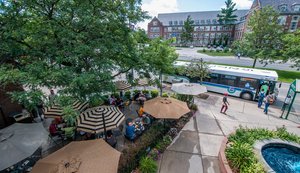Ecology and Sustainability of a City
Author: Kristina Gerding
The beauty of a city can be seen in all aspects of life that encompass it. With the emergence of urban development sweeping its way through the global world, it remains vital that cities keep a strong ecological connection. The need for green sustainable cities is becoming increasingly prevalent in today’s societies. Connecting a city with the nature that surrounds it gives the residents and visitors not only a beautiful city to explore, but also a sense of belonging to a sustainability community. The new urban movement needs to help foster these ecological ideals in modern and creative ways.
In many urban cities, the issue of expansion and growth is being met with issues of sustainability for the environment. One program that is helping to counteract this negative growth is the Urban Health Initiative. This initiative aims to effectively connect city development with issues of environmental health. By informing cities on things such as better waste management and cleaner air quality this initiative is making steps towards cleaner cities. This is just one example of a program that is encouraging cities to look at the links between sustainability factors and smart growth in an urban area. The city of Curitiba, Brazil is another example of how a city is working towards a greener future. This city has been successful in integrating more green space and cleaner transportation despite the rapidly growing number of residents in the area. Their initiatives target lower income residents by giving them access to a broad spectrum of environmentally clean and healthy programs. This in turn leads Curitiba residents to recycle over 50% of trash and to have longer lifespans than the national average. Implementations for sustainability such as the ones set by this growing Brazilian city can be mirrored in other expanding urban cities.
An immense factor of ecological and sustainable success in a city is a strong push from not only the individuals in the community but also the government officials and urban builders. Influential organizations and members of a city can greatly impact how ecology is integrated throughout an urban space. As mentioned in the Shaping space for civic life: Can better design help engage citizens article, the importance of a civic space such as neighborhood parks is vital in the engagement of a community. Clean and highly used parks in a city are directly related to satisfaction in local government. How a city connects to the nature around it can be more than simply green park spaces though. Creative and innovative minds are the building blocks to which great urban ideas are formed on. Integrating nature into urban spaces can be challenging but easily solved with innovative solutions.
Along with the environmental and health impacts of greener cities, urban cities that have areas with strong connections to nature create a more livable city overall. Successful cities are more than just the infrastructure that encompasses them, but rather a thriving and appealing space for all to enjoy. Green parks create gathering points for the community and visitors to enjoy an escape from the constant hustle of urban life. Walkways surrounded by nature connect areas of a city while also supporting healthy physical activity. By implementing areas such as these, cities are not only cutting down on environmental costs but also healthcare expenses as well. Underlying benefits to green spaces such as these are often being taken over by the need for expanding cities to urbanizes with buildings and transportation. The importance of integrating ecology cannot be lost in the need for expansion. If the urban movement is going to be successful in all aspects, cities need this integration of nature for not only sustainability but also livability.
When thinking of reasons students may come to Michigan State, one of the first to pop into my mind besides academics, is the beautiful campus students here call home. This connection to nature gives the campus an identity of attractiveness and sustainability. Whether it is the river that runs through the center of campus or the thousands of trees that line the walkways, MSU has deeply integrated nature into its development throughout the years. These natural aspects and ideas expand out into the greater East Lansing area and provide a sense of community in all aspects of life here. As Majora Carter says in her TED Talk, a connection to nature can provide a sense for a unified community. Implementing eco-friendly projects in a city helps to revive dead spaces. Her example of using these eco-friendly projects in the Bronx and how that lead to revitalization in less privileged communities show the power of ecology in a community. So, whether it is East Lansing or the Bronx, a strong connection to nature provides sustainability for all aspects of a city.
An example of this principle at work: Urban Health Initiative/ Healthy and equitable urban planning
Back